Books

Each child chooses or invents his or her own story and illustrates it.
During the year the children make at least one book or sometimes several depending on their working rhythm. Like real illustrators and sometimes authors, the children invent, construct and realize an art book.
Making a book lets the children acquire technical mastery in a playful way while exploring their inner landscapes. They choose the story: no subject is imposed. An illustrated book – even without text – tells a story. Designing and making a book means structuring its narration: choosing the layout, thinking about humor and moments of tension to keep the future reader of the book being created in suspense.
Through this realization, children learn the principles of pictorial and written narration of stories. Moreover, seeing a project through to completion cultivates essential perseverance, technical precision, and the development of the imagination, while bringing great satisfaction and building self-esteem.
Drawing
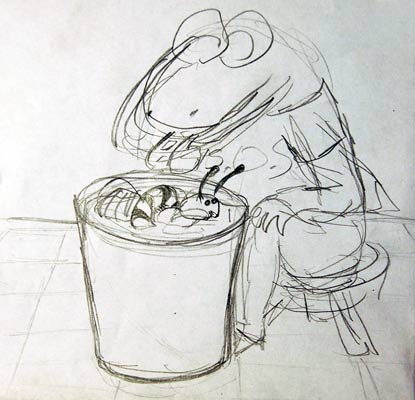
Drawing is a natural form of expression in young children which they learn progressively as they get older. Learning to observe the outside world allows children to integrate into their drawings: movement, rhythm, shadows and light.
Drawing is a form of writing specific to the world of art. It helps to develop concentration, real self-awareness, observation of the outside world and also of the inner landscape.
Painting
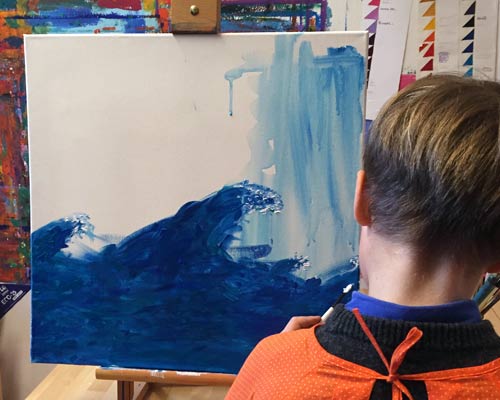
Painting at the Atelier involves the exploration of different supports and various creative processes.
Painting on paper with ink is a very fluid technique which is excellent for portraits or spontaneous colors.
Painting on canvas with extra-fine acrylics is a much longer process. This is done over the course of several sessions. The idea is to have the experience, like a real painter, of spending a lot of time on one picture, building the painting layer by layer. The material guides the thinking and the intention of the thinking guides the brush. In this interaction between thought and materials, the participants live the experience of patience, the magical technique of mixing colors and opening themselves to the forms that emerge by chance, which are a painter's real tools.
Painting on walls with a wide range of gouaches lets participants experiment with thinking and artistic realization using large, free movements. The spontaneous painting produced integrates the movement of the whole body.
This is a moment of letting go in which no esthetic result is expected. What is important here is the pleasure of mixing colors, the shapes that emerge at random and the body movements that are necessary for the realization.
Illustration
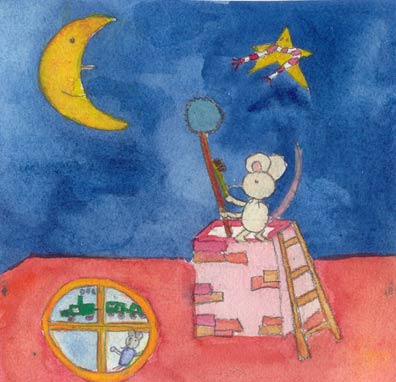
Illustration literally means shedding light on a statement, or in this case a text. Each child illustrates a story and works towards his or her future book.
The books are mostly illustrated with (extra-fine) watercolors which allow for the mixing of colors to obtain infinite nuances. This is a subtle and precise technique which delights children and is easy to master at any age.
As illustration means shedding light on a text, the children also learn how to choose the key moments of their stories, to do the layout in a way that is entertaining and that will draw the attention of the reader of their future book, to structure the pictorial narration in order to create moments of tension and to keep the reader in suspense.
Writing stories
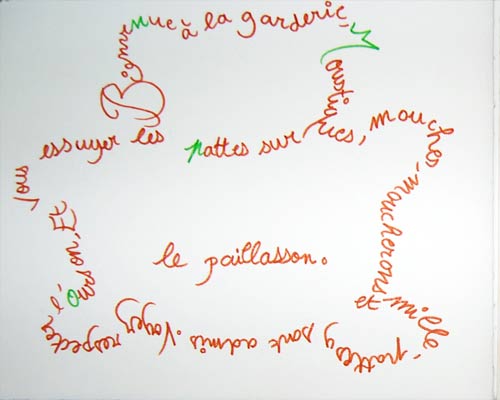
Inventing a story is an art in itself which is appealing to some children.
Drawing means constantly inventing new worlds. Inventing a story requires a guiding thread and a rationale as well as a particular linguistic relevance.
The thought of having to write a story is intimidating to some people, so only those who want and choose to undertake this, learning the rules and tricks of the trade in the process.
However, children who choose existing stories (e.g. classics or tales) are free to explore their capacities for invention in the choices of the colored atmospheres, the characters and their expressions, and they often include in their stories passages which did not exist in the original.
When the children copy their stories (invented or not) into their books, we don't correct the spelling mistakes. Free writing lets them feel at ease in inventing the text. What we call "mistakes" are simply an indicator of their phonetic capacity which is still young. They will be an endearing memory of the time when they made their book.
Modeling Sculpture
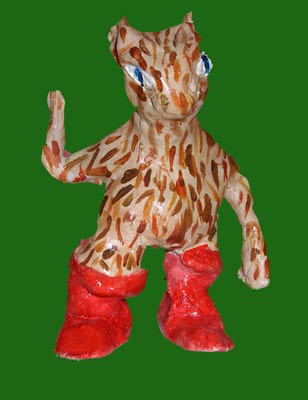
Clay which hardens in the open air is always available at the Atelier.
The shift from two dimensions to volumes in 3D is essential. Modeling allows for a different type of expression, leading to a better understanding of shapes, making construction more palpable.
Handling clay also has a powerfully calming effect.
The objects made are sometimes decorated, painted or enriched with other materials.
Puppets
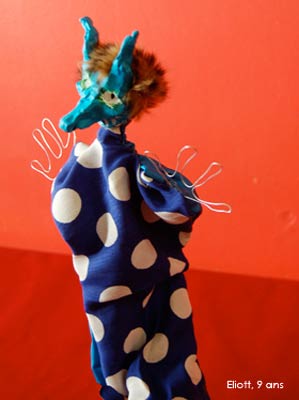
Creating puppets is a magical activity.
Out of nothing appear characters who have personalities determined by their expressions, their sizes, and their colors. Sewing clothes for them, developing an identity and a voice for them, and playing with them is a unique experience which children greatly enjoy.
Various puppet techniques are offered at the Atelier: Marionettes, rod puppets, finger and hand puppets, puppets created from found objects.
Sewing
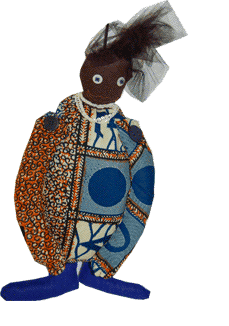
Sewing is often used in the making of clothes for puppets, but also for making stuffed animals, bags, cushions and in all situations where a child wants to make something that requires this technique. Some children at the Atelier have made clothes on mannequins for themselves or for their mothers!
Hand sewing improves fine motor skill, concentration, attention and the capacity for design.
Tinkering (Arts and Crafts)
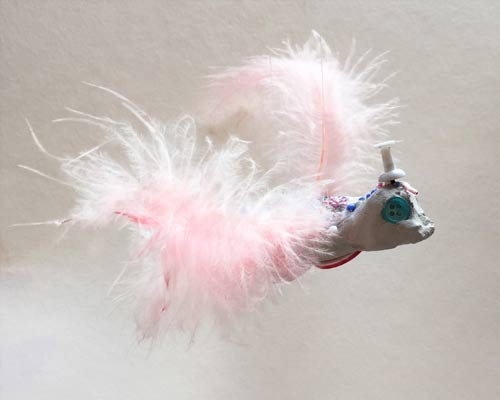
Creating something from nothing is the most singular type of creation.
The Atelier has an abundant supply of fabrics, beads and buttons, wire, wood and autumn leaves of all tones and shapes, ribbons, wool and lace, pebbles, sand, shells and pieces of driftwood. With their shapes and their simplicity, the materials invite us to create unusual objects that are full of life.
Tinkering is a more raw and spontaneous form of creation. It means working with the natural beauty of the elements which, by their shapes, inspire the idea of a creation.
Painting and music

Once a year, a professional musician is invited to the Atelier for a "live" exploration of the interaction between the worlds of music and painting. The musician plays pieces of his or her choice and also improvisations while the children explore the rhythms, the nuances and the artistic themes to compose their paintings.
A piece of music is often composed of several interwoven melodies (themes). These various themes are connected: sometimes they accompany each other, cross over and respond to each other, and amplify each other. Then they give way to silence, and they resume. In music, there are rhythms, nuances, tones, and intensities. The fine arts use the same notions. Different themes are addressed on different levels, weaving links between them, choosing rhythms, and "silences": "empty space" in painting, tones and nuances.
Animation

Make an animated film! Animate your own decor and illustrations as on this site.
By drawing, painting, and building the decor for an animated film, children not only learn fine arts techniques, they also develop a narration which is directly set in motion.
Animation develops 3D awareness, structuring of the narration, and the planning of moments of tension to keep the future spectator of the film in suspense.

